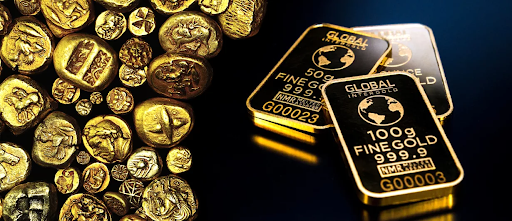When it comes to investments or major purchases like jewelry, tracking the today gold rate in India is crucial for making informed decisions. Gold, often regarded as one of the safest investment options, plays a significant role in Indian culture, be it during festive occasions, weddings, or as a secure investment in uncertain times. However, the price of gold can vary not only from day to day but also across cities. Have you ever wondered why the gold rate fluctuates or differs between Mumbai, Delhi, Chennai, or even in smaller towns? Let’s break it down and understand how the gold rate is determined and why it differs across locations.
Understanding the Factors That Influence the Today Gold Rate in India
Gold rates in India are determined by a multitude of factors that impact the global and domestic economy. Here are some of the key elements:
1. International Gold Prices
Gold is a global commodity and its prices are primarily determined by international markets, particularly in London and New York. India imports the vast majority of its gold, so any change in the global gold price directly affects the today gold rate in India. These international prices are in US dollars and subject to fluctuations based on geopolitical events, global supply-demand dynamics, or economic crises.
For instance:
- When global markets see instability (e.g., recession fears or wars), demand for gold surges as investors look for safe-haven assets, leading to a rise in gold prices.
- Conversely, when economies stabilize and stock markets perform well, gold prices may decline as focus shifts to other investment options.
2. Exchange Rate Impact
Since India imports gold, the value of the Indian rupee (INR) against the US dollar plays a vital role in determining the price. A weaker rupee makes gold more expensive, while a stronger rupee makes it relatively cheaper. Even a minor fluctuation in the INR-USD exchange rate can affect the 5 gram gold value or the overall gold price across Indian cities.
3. Import Duty and Taxes
India imposes an import duty on gold, which makes it costlier than the international rate for Indian buyers. The import duty rate in India is dictated by government policies and may be altered based on trade deficits or macroeconomic conditions. Additionally, other taxes such as GST (Goods and Services Tax) are levied on gold products. Altogether, taxes add up to the final cost, impacting the today gold rate in India.
4. Local Demand and Supply
India is one of the largest consumers of gold in the world, and local demand heavily influences prices. Festivals like Diwali, Dhanteras, Akshaya Tritiya, and wedding seasons often witness a surge in gold purchases, pushing up the price. On the flip side, when demand slows down, the price may stabilize or decline.
5. Market Speculation
Speculators who trade in gold derivatives or futures on global as well as Indian commodity exchanges (such as MCX) contribute to price fluctuations. Market sentiment, along with speculative buying or selling, can cause short-term changes in the rates.
Why Does the Gold Rate Differ Across Cities in India?
Apart from the global factors discussed above, gold rates vary across different cities in India due to local differences. If the today gold rate in India is ₹5,500 per gram in one city, it might be ₹5,520 in another. Here’s why:
1. Transportation Costs
The cost to transport gold from one region or port to another plays a role in price differences. For coastal cities like Mumbai or Chennai, transportation costs are relatively low as the gold is directly imported through nearby ports. However, for interior cities like Jaipur or Lucknow, transportation adds to the final cost.
2. State Taxes and Duties
Different states impose varying levels of local taxes, such as Value Added Tax (VAT) or octroi duty. This discrepancy leads to variations in the today gold rate in India from one region to another.
For example:
- Gold prices in Maharashtra might be different from Karnataka due to differences in local tax structures.
- Additionally, metropolitan cities usually have slightly higher charges compared to small towns.
3. Jeweler’s Premium
Jewelry stores across India do not sell gold at a uniform price. Jewelers add different levels of premiums over the base price for factors like making charges, margins, and overheads. For instance, a jeweler in Delhi may quote a slightly different price than a jeweler in Kolkata due to variations in operating costs and market competition.
4. Purity of Gold
The rate of gold depends on its purity—24K, 22K, or 18K. Generally, 24-carat gold (pure gold) is more expensive than 22-carat gold, commonly used in jewelry. While the purity standard is uniform, variations in purity certification processes across cities can sometimes contribute to minor price differences.
5. Competition and Market Conditions
Cities with a higher number of gold dealers may have slightly competitive pricing to attract customers. On the other hand, cities with fewer jewelry stores might see higher premiums, affecting the price.
Monitoring Today Gold Rate and Making Informed Purchases
With so many factors contributing to gold rate fluctuations across cities, how can you ensure a good deal while buying gold? Here’s a step-by-step guide:
1. Track Prices Daily
Since the today gold rate in India can fluctuate significantly from one day to the next, it’s wise to track prices regularly. Many online platforms, bank websites, and jewelry stores offer real-time updates on gold rates based on your city.
2. Compare Across Cities
If you’re in a situation where you can purchase gold from different regions, compare prices among cities. This might help you save on costs by choosing a location with lower rates.
For instance:
- If the 5 gram gold value is cheaper in Chennai compared to Delhi due to lower transportation costs, you might consider making the purchase in Chennai, provided additional costs like travel don’t outweigh the savings.
3. Purity Verification
Always check for BIS (Bureau of Indian Standards) Hallmark certification to ensure purity and authenticity. This ensures consistency in pricing, even if city-based premiums differ.
4. Invest in Gold ETFs or Sovereign Bonds
If you’re buying gold as an investment, consider alternatives like Gold Exchange-Traded Funds (ETFs) or Sovereign Gold Bonds. These financial instruments allow you to invest in gold digitally without worrying about city-specific price differences.
Outlook for Gold Prices in India
Gold prices are likely to remain volatile in the future, given global economic uncertainty, inflation trends, and geopolitical risks. Many experts believe that gold demand in India will continue to grow due to cultural factors and its status as a secure form of investment.
While 2023 started with high gold prices due to global inflation fears, the impact of central bank policies, especially from the U.S. Federal Reserve, continues to influence the today gold rate in India. Domestically, factors like the festive season and upcoming elections could further drive demand and prices.
Conclusion
The today gold rate in India is influenced by a combination of international factors, local demand-supply dynamics, currency exchange rates, and government policies. Additionally, transportation costs, local taxes, jeweler fees, and other regional factors contribute to variations in prices across Indian cities. Tracking these variables can help you make informed decisions, whether you’re buying gold for personal use or as an investment.
Before making a purchase, always ensure that you verify rates, compare across cities if feasible, and check for hallmark certification. Whether you’re looking at buying a simple 5 gram gold value as a gift or considering a significant investment in gold bars or ornaments, being informed can make all the difference. Gold remains an integral part of Indian heritage and wealth-building strategies, so understanding its pricing dynamics is essential for maximizing its value.




